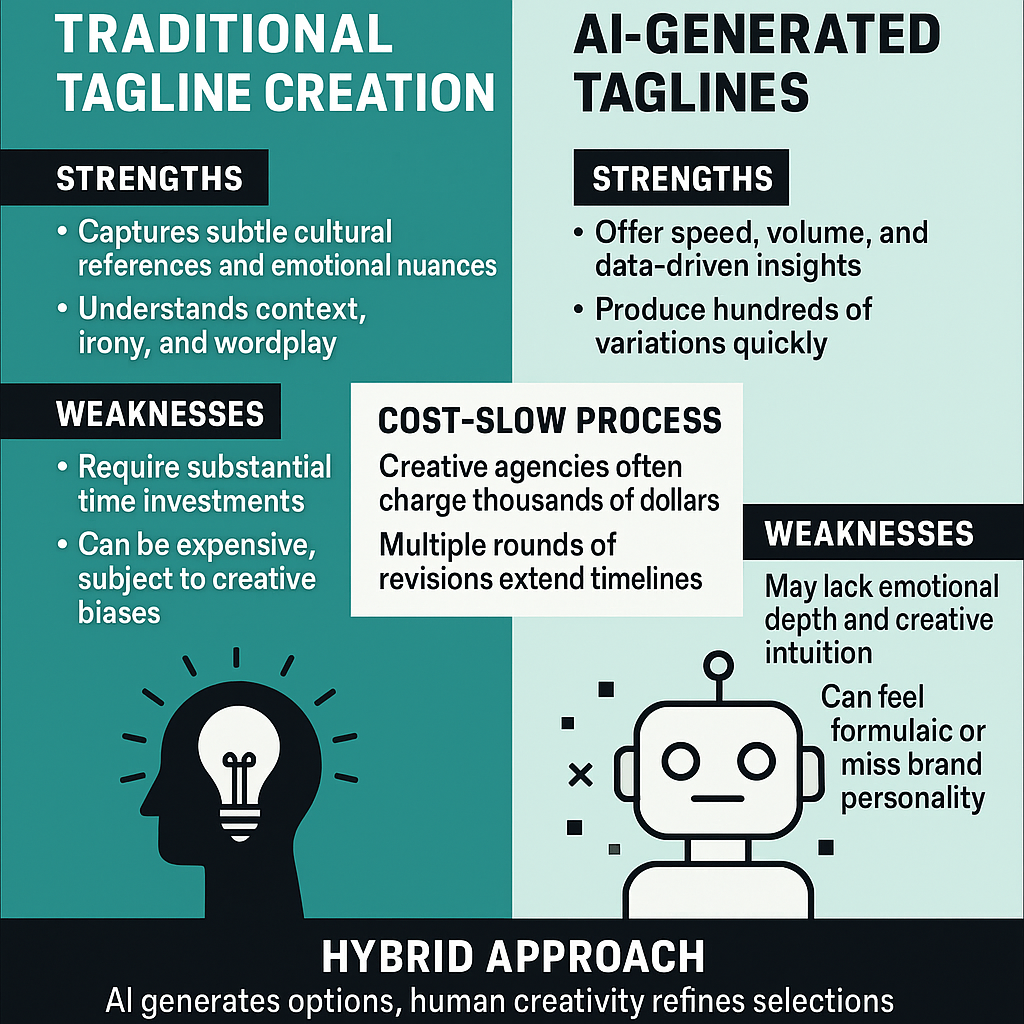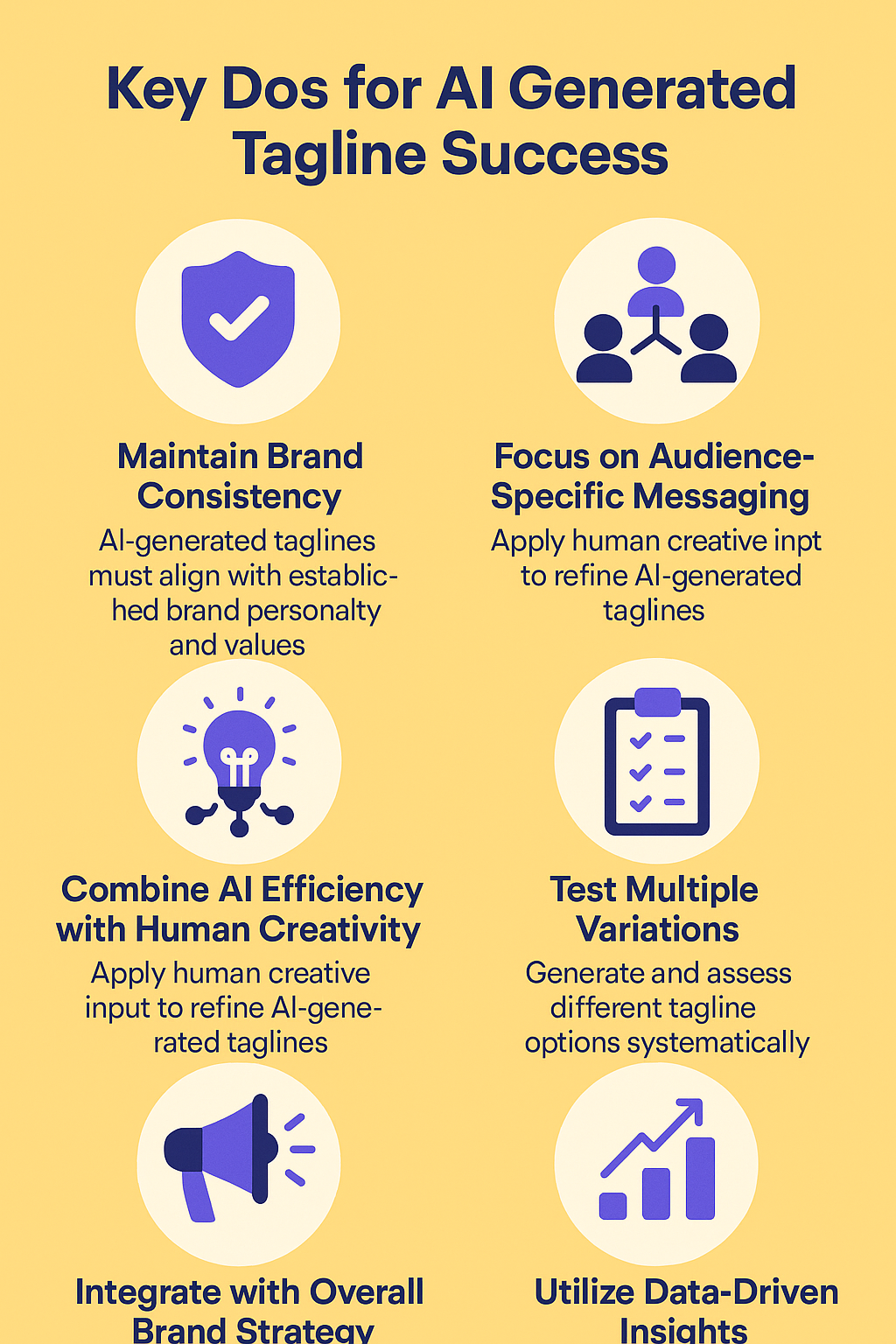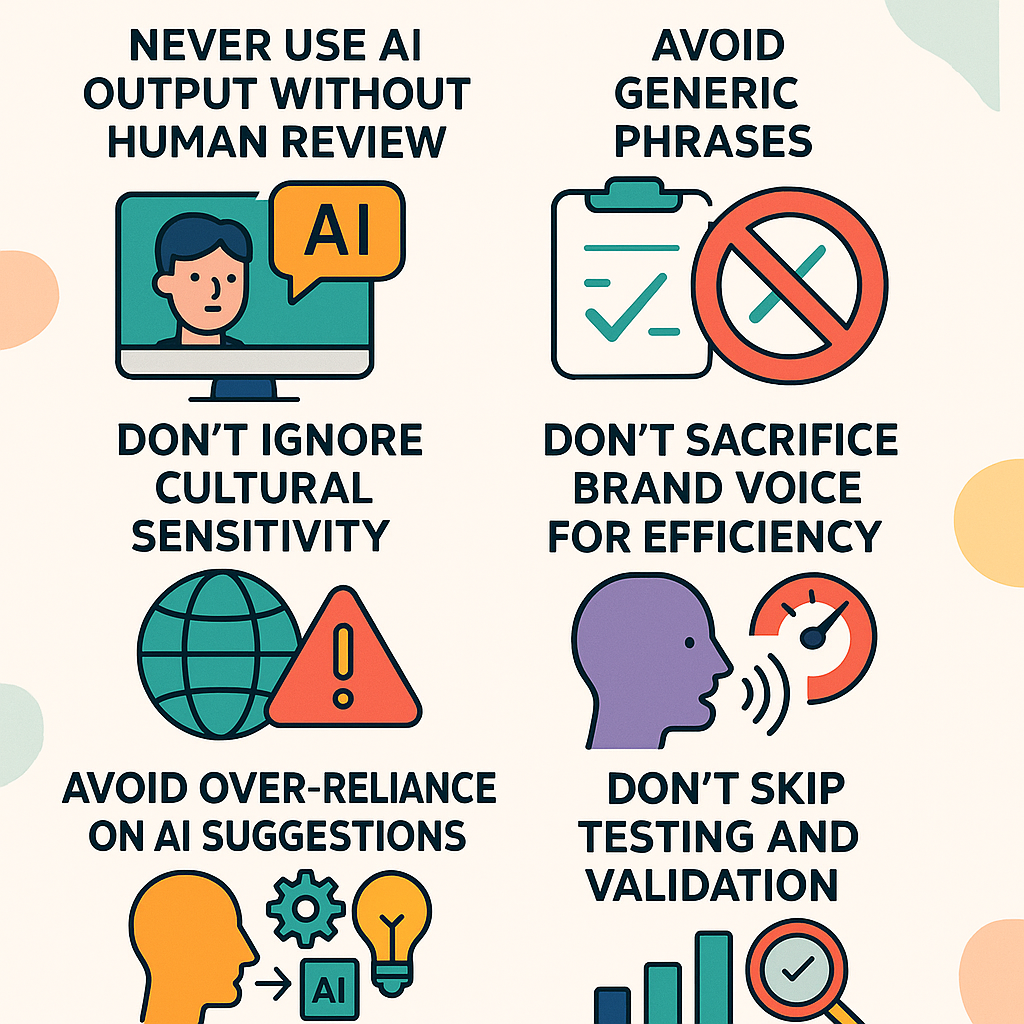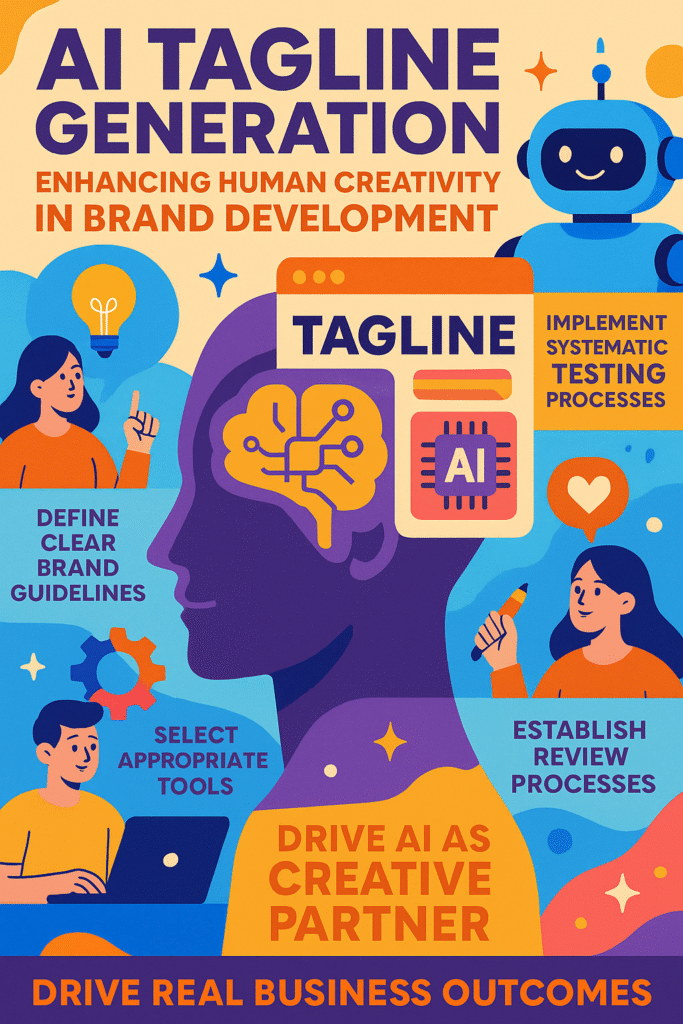Table of Contents
AI generated taglines are reshaping how companies create memorable brand messages. Modern businesses face intense pressure to stand out in crowded markets while maintaining authentic connections with their audiences. The challenge becomes even more complex when brands need dozens of variations for different campaigns, products, or market segments.
Traditional slogan creation often takes weeks of creative sessions, expensive agency fees, and multiple revisions. Many small businesses and startups simply cannot afford this lengthy process. Meanwhile, established companies struggle to maintain creative consistency across multiple campaigns while keeping costs manageable.
Artificial intelligence offers a compelling solution to these challenges. Smart algorithms can generate hundreds of creative taglines in minutes, analyze market trends, and adapt messaging for different audiences. However, the technology also presents unique risks that could damage brand reputation if not handled properly.
The stakes have never been higher for brand messaging. Companies that master AI tagline generation gain significant competitive advantages, while those that misuse the technology risk creating generic, forgettable, or even harmful messaging that alienates customers.
The Role of AI in Modern Tagline Creation
Artificial intelligence has fundamentally changed how brands approach slogan development. Machine learning algorithms analyze vast databases of successful marketing campaigns, consumer psychology patterns, and linguistic structures to generate compelling brand messages.
Modern AI systems can process thousands of competitor taglines, identify successful patterns, and create original variations that resonate with target audiences. These tools understand context, emotional triggers, and cultural nuances that influence consumer behavior.
The speed advantage alone makes AI attractive for businesses. What once required weeks of creative development can now happen in hours. Companies can test multiple variations, analyze performance data, and refine their messaging based on real-world results.
AI tools also provide unprecedented access to creative resources. Small businesses can now generate professional-quality taglines without hiring expensive creative agencies. This democratization of creative tools levels the playing field between established corporations and emerging brands.
The technology continues evolving rapidly. Current AI systems can analyze sentiment, predict emotional responses, and even adapt messaging for specific cultural contexts. These capabilities were impossible just a few years ago but are now standard features in many platforms.
How AI Enhances Tagline and Slogan Development
AI-powered creative tools bring several distinct advantages to brand messaging. They eliminate creative blocks that often plague traditional development sessions. When human writers struggle with inspiration, AI can generate fresh perspectives and unexpected word combinations.
According to research from Harvard Business Review, AI tools can analyze consumer behavior patterns and predict emotional responses to different messaging approaches. This capability helps brands create more targeted and effective taglines.
Pattern recognition capabilities allow AI to identify trending phrases, emotional triggers, and successful messaging formulas across different industries. This analysis helps create taglines that feel current and relevant to modern consumers.
Personalization becomes possible at scale with AI assistance. Brands can generate variations tailored to specific demographics, geographic regions, or product categories. This level of customization was previously impossible without significant time and budget investments.
AI tools also provide objective feedback on tagline effectiveness. They can analyze readability scores, emotional impact, and memorability factors that human creators might miss. This data-driven approach reduces guesswork in the creative process.
The technology excels at generating volume without sacrificing quality. AI can produce hundreds of variations in minutes, allowing brands to explore creative territories that would be impossible to cover through traditional methods.
Advanced AI systems can also analyze competitor messaging and identify gaps in the market. This competitive intelligence helps brands position themselves uniquely and avoid messaging that sounds too similar to existing competitors.
Traditional vs AI-Generated Taglines

Traditional tagline creation relies heavily on human creativity, intuition, and experience. Creative professionals spend considerable time researching target audiences, analyzing competitors, and developing concepts through multiple iterations.
The human approach excels at capturing subtle cultural references, emotional nuances, and brand storytelling elements that resonate deeply with specific audiences. Human creators understand context, irony, and wordplay in ways that current AI systems cannot fully replicate.
However, traditional methods have significant limitations. They require substantial time investments, can be expensive, and may suffer from creative biases or limited perspectives. Human creators might also struggle with generating large volumes of variations needed for comprehensive testing.
Creative agencies often charge thousands of dollars for tagline development projects. This cost barrier prevents many smaller businesses from accessing professional creative services. The process can also be slow, with multiple rounds of revisions and approval processes extending timelines significantly.
AI-generated taglines offer speed, volume, and data-driven insights that traditional methods cannot match. They can produce hundreds of variations quickly, analyze performance metrics, and adapt messaging based on real-time feedback.
Studies from MIT Sloan Management Review show that companies using AI for creative tasks report 40% faster project completion times while maintaining quality standards. This efficiency gain allows brands to test more variations and optimize messaging more effectively.
Yet AI approaches have their own weaknesses. They may lack the emotional depth, cultural sensitivity, and creative intuition that human writers bring to brand messaging. AI-generated content can sometimes feel formulaic or miss subtle brand personality traits.
The most successful approach combines both methods. AI provides the initial creative foundation and generates numerous options, while human creativity refines and perfects the final selections. This hybrid approach leverages the strengths of both artificial and human intelligence.
Essential Guidelines for AI Tagline Generation
The foundation of successful AI tagline creation starts with clear brand guidelines and objectives. Companies must define their brand voice, target audience, and core messaging priorities before engaging AI tools.
Providing comprehensive context helps AI systems generate more relevant and authentic taglines. This includes brand history, values, target demographics, and competitive landscape information. The more context available, the better AI can align generated content with brand requirements.
Setting specific parameters improves AI output quality. Define desired tone, length, key messages, and any words or phrases to avoid. These constraints help AI focus on generating relevant options rather than generic suggestions.
Regular human oversight remains crucial throughout the process. AI should supplement human creativity, not replace it entirely. Human reviewers can identify subtle issues, cultural sensitivities, and brand alignment problems that AI might miss.
Testing and iteration are essential for optimizing AI-generated taglines. Use A/B testing to compare performance across different variations. Analyze engagement metrics, conversion rates, and brand recall to identify the most effective options.
Brand consistency must remain a priority throughout the AI generation process. Every tagline should align with established brand personality and reinforce key brand messages. This consistency builds stronger brand recognition and customer trust.
Key Dos for AI Generated Tagline Success

Maintain Brand Consistency
AI-generated taglines must align with established brand personality and values. Review all generated options against brand guidelines to ensure consistency across all marketing materials. This alignment helps build stronger brand recognition and trust with consumers.
Consistency extends beyond just tone and voice. Consider how taglines will appear across different marketing channels and touchpoints. Social media, print advertising, and video content may require slight variations while maintaining core messaging integrity.
Focus on Audience-Specific Messaging
Tailor AI prompts to generate taglines for specific audience segments. Different demographics respond to different messaging styles, emotional triggers, and communication preferences. Segment-specific taglines perform better than generic, one-size-fits-all approaches.
Consider cultural differences, age groups, and lifestyle preferences when developing audience-specific messaging. AI can help generate variations that resonate with different market segments while maintaining brand consistency.
Combine AI Efficiency with Human Creativity
Use AI to generate initial concepts and variations, then apply human creativity to refine and perfect the final selections. This hybrid approach leverages the speed of AI while maintaining the emotional intelligence and cultural awareness that humans provide.
Human creativity adds the finishing touches that make taglines truly memorable. This includes wordplay, cultural references, and emotional nuances that AI might miss. The combination creates more compelling and effective brand messaging.
Test Multiple Variations
Generate numerous tagline options and test them systematically. AI excels at creating variations, so take advantage of this capability. Test different approaches, lengths, and emotional tones to identify what resonates most with target audiences.
Testing should include both quantitative metrics and qualitative feedback. Use analytics to measure performance and focus groups to understand emotional responses. This comprehensive approach provides deeper insights into tagline effectiveness.
Integrate with Overall Brand Strategy
Ensure AI-generated taglines support broader marketing objectives and brand consistent visuals. Taglines should complement other brand elements and reinforce key messages across all touchpoints.
Consider how taglines will work with existing marketing materials, advertising campaigns, and brand positioning. This integration ensures cohesive brand experiences that strengthen customer relationships.
Utilize Data-Driven Insights
AI tools provide valuable data about tagline performance and audience response. Use these insights to refine future generation sessions and improve overall messaging effectiveness.
Analyze which phrases, emotional triggers, and messaging approaches perform best with target audiences. This data helps optimize AI prompts and generates more effective taglines over time.
Critical Don’ts to Avoid

Never Use AI Output Without Human Review
AI-generated taglines require careful human evaluation before implementation. Automated systems can produce grammatically correct but contextually inappropriate or culturally insensitive content. Always have qualified humans review and approve AI-generated options.
Human review should include multiple perspectives and stakeholders. Marketing team members, brand managers, and target audience representatives can identify different potential issues and opportunities.
Avoid Generic Phrases
AI systems sometimes generate predictable or overused phrases that fail to differentiate brands. Review generated content for originality and uniqueness. Avoid taglines that could apply to any company in the industry.
Research competitor messaging to ensure generated taglines stand out in the marketplace. Unique positioning helps brands capture attention and build stronger customer relationships.
Don’t Ignore Cultural Sensitivity
AI may not fully understand cultural nuances, local customs, or sensitive topics. Review generated content for potential cultural issues, especially when targeting diverse markets or international audiences.
Include cultural experts and local market representatives in the review process. Their insights help identify potential problems and opportunities that AI might miss.
Don’t Sacrifice Brand Voice for Efficiency
While AI can generate taglines quickly, speed should not compromise brand authenticity. Ensure generated content maintains the unique voice and personality that distinguishes the brand from competitors.
Brand voice consistency builds customer trust and recognition. Maintain this consistency even when using AI tools to generate new messaging options.
Avoid Over-Reliance on AI Suggestions
AI should enhance human creativity, not replace it. Maintain creative control and use AI as a tool to support, not drive, the creative process. The final decisions should always reflect human judgment and brand expertise.
Balance AI efficiency with human insight to create the most effective taglines. This approach combines the best of both artificial and human intelligence.
Don’t Skip Testing and Validation
Even the most promising AI-generated taglines need thorough testing before implementation. Skip this step at your own risk, as untested taglines might not perform as expected with real audiences.
Testing reveals insights about audience preferences, emotional responses, and performance metrics that inform future tagline development efforts.
Common Challenges and Solutions
Challenge: Generic Output
AI systems sometimes generate predictable or formulaic taglines that lack uniqueness. This happens when prompts are too broad or when AI draws from limited training data.
Solution: Provide specific, detailed prompts that include unique brand attributes, target audience insights, and desired emotional outcomes. Use multiple AI tools to generate diverse perspectives and combine the best elements from different sources.
Challenge: Brand Misalignment
Generated taglines may not accurately reflect brand personality or values. This occurs when AI lacks sufficient context about brand identity and positioning.
Solution: Develop comprehensive brand briefs that include personality traits, values, voice guidelines, and examples of approved messaging. Train AI systems with brand-specific data to improve alignment with company identity.
Challenge: Cultural Insensitivity
AI may generate content that is inappropriate for specific cultural contexts or markets. This risk increases when targeting diverse audiences or international markets.
Solution: Implement thorough review processes that include cultural experts and local market representatives. Test generated content with focus groups from target demographics before final approval.
Challenge: Lack of Emotional Depth
AI-generated taglines sometimes feel mechanical or lack the emotional resonance that drives consumer behavior. This limitation can reduce tagline effectiveness and brand connection.
Solution: Combine AI generation with human creativity to add emotional depth and cultural relevance. Use AI for initial concepts and human insight for emotional refinement.
Challenge: Overuse of Popular Phrases
AI systems may generate taglines that rely too heavily on trending phrases or popular expressions. This can make brand messaging feel dated or unoriginal.
Solution: Regularly update AI training data and prompts to avoid overused phrases. Focus on unique brand attributes and distinctive positioning to generate more original content.
Top AI Tools for Taglines Generation
Several AI platforms excel at generating creative taglines and slogans. Each tool offers unique features and capabilities that suit different business needs and budgets.
Copy.ai provides user-friendly interfaces and templates specifically designed for tagline generation. The platform offers multiple creative approaches and allows easy iteration on generated concepts. Its strength lies in generating variations quickly and providing different creative angles for the same brand message.
Jasper AI excels at maintaining brand voice consistency across generated content. Its advanced language models can adapt to specific brand personalities and maintain consistent messaging tone. The platform also offers collaboration features that help teams work together on tagline development.
Writesonic offers comprehensive slogan generation features with built-in optimization tools. The platform includes performance analysis capabilities that help identify the most effective tagline options. Its integration with marketing tools makes it easy to test and implement generated content.
ChatGPT provides flexible, conversational approaches to tagline development. Users can engage in iterative creative sessions and refine concepts through ongoing dialogue. The platform excels at understanding context and generating creative variations based on detailed prompts.
Peppertype.ai specializes in marketing copy generation with specific tools for taglines and slogans. The platform integrates with popular marketing tools and provides campaign-specific optimization features. Its focus on marketing applications makes it particularly useful for brand messaging.
Rytr offers affordable tagline generation with multiple creative modes and templates. The platform provides good value for small businesses and startups that need professional-quality taglines without significant budget investments.
Research from Forrester indicates that 73% of marketers using AI tools report improved campaign performance and faster content creation cycles. This data supports the growing adoption of AI-powered creative tools across industries.
Each tool has strengths and weaknesses, so many successful brands use multiple platforms to generate diverse creative options. This approach provides broader creative perspectives and helps identify the most effective messaging approaches.
Best Practices for Implementation
Start with clear objectives and success metrics before generating taglines. Define what success looks like for each campaign or brand initiative. This clarity helps evaluate AI-generated options against specific goals.
Create comprehensive brand guidelines that AI tools can reference. Include voice characteristics, approved terminology, avoided phrases, and examples of successful past messaging. These guidelines ensure generated content aligns with brand identity.
Establish review processes that include multiple stakeholders. Include marketing team members, brand managers, and target audience representatives in the evaluation process. Different perspectives help identify potential issues and opportunities.
Implement systematic testing approaches to evaluate tagline effectiveness. Use A/B testing, focus groups, and performance analytics to measure impact. This data helps refine AI prompts and improve future generation sessions.
Document successful approaches and prompts for future reference. Keep records of effective strategies, useful AI tools, and successful tagline formulas. This knowledge base improves efficiency and consistency over time.
Train team members on AI tool capabilities and limitations. Understanding what AI can and cannot do helps teams use these tools more effectively and avoid common pitfalls.
Integration with Broader Marketing Strategy
AI-generated taglines work best when integrated with comprehensive marketing strategies. They should complement multimedia marketing efforts and support overall brand positioning objectives.
Consider how taglines will appear across different marketing channels. Social media, print advertising, and video content may require different approaches or variations. AI can help generate channel-specific versions that maintain consistent messaging.
Align tagline development with broader brand voice initiatives. Ensure generated content supports established communication guidelines and reinforces key brand messages across all touchpoints.
Integrate taglines with visual branding elements and creating immersive content strategies. The combination of compelling taglines and engaging visuals creates more powerful brand experiences.
Real-World Success Stories
McDonald’s “I’m Lovin’ It” demonstrates how simple, memorable taglines can become global brand identifiers. While not AI-generated, this slogan exemplifies the characteristics that AI tools should aim to replicate: simplicity, memorability, and emotional connection.
The tagline succeeded because it captured the brand’s focus on customer satisfaction and enjoyment. It works across different cultures and languages, making it effective for global marketing campaigns. According to Marketing Land, this tagline contributed to a 15% increase in brand recognition within the first year of implementation.
Nike’s “Just Do It” showcases the power of action-oriented messaging that motivates audiences. AI tools can analyze successful patterns like this to generate similar motivational taglines for sports and fitness brands.
The phrase became iconic because it aligned perfectly with Nike’s brand personality and customer aspirations. It motivated action while reinforcing the brand’s position as a leader in athletic performance.
Apple’s “Think Different” illustrates how taglines can embody brand philosophy and differentiate companies from competitors. AI can help identify unique positioning opportunities and generate taglines that capture distinctive brand attributes.
This tagline succeeded because it positioned Apple as an innovative, creative company that challenged conventional thinking. It attracted customers who saw themselves as creative and independent. Research from Brand Finance shows that Apple’s consistent messaging contributed to becoming the world’s most valuable brand.
Mastercard’s “Priceless” campaign shows how taglines can create emotional connections while reinforcing brand benefits. The campaign’s success demonstrates the importance of emotional resonance in effective brand messaging.
These examples provide templates that AI systems can analyze and adapt for different industries and brand personalities. The key is understanding why these taglines succeeded and applying those principles to new creative challenges.
Measuring Tagline Effectiveness
Successful AI tagline implementation requires robust measurement strategies. Track key performance indicators that directly relate to business objectives and brand goals.
Brand Recall Metrics measure how well audiences remember and associate taglines with specific brands. Conduct surveys and focus groups to assess memorability and brand connection strength.
Engagement Rates across different marketing channels provide insights into tagline effectiveness. Monitor social media engagement, click-through rates, and conversion metrics to understand audience response.
A/B Testing Results offer direct comparisons between different tagline options. Test variations across email campaigns, advertising, and social media to identify the most effective approaches.
Sales Impact Analysis connects tagline performance to business outcomes. Track revenue changes, conversion rates, and customer acquisition metrics during tagline implementation periods.
Brand Sentiment Analysis measures how taglines influence customer perceptions and emotional responses. Monitor social media mentions, reviews, and customer feedback to understand brand sentiment changes.
Tools like Brandwatch and Hootsuite Insights provide comprehensive sentiment tracking capabilities that help brands understand tagline impact on customer perceptions.
Market Share Tracking helps evaluate tagline impact on competitive positioning. Monitor brand awareness and market share changes following tagline implementation.
Advanced AI Tagline Strategies
Seasonal Adaptation
AI can generate taglines that adapt to seasonal trends, holidays, and cultural events. This approach keeps brand messaging fresh and relevant throughout the year.
Seasonal taglines work particularly well for retail, food service, and consumer goods brands. They create timely connections with customers and support seasonal marketing campaigns.
Micro-Targeting
Advanced AI tools can generate taglines for very specific audience segments or use cases. This precision targeting improves message relevance and response rates.
Micro-targeted taglines work well for digital marketing campaigns where precise audience segmentation is possible. They increase conversion rates by speaking directly to specific customer needs.
Real-Time Optimization
Some AI platforms can adjust taglines based on real-time performance data. This dynamic approach optimizes messaging continuously for better results.
Real-time optimization works best for digital campaigns where performance data is immediately available. It helps brands respond quickly to changing market conditions.
Future Trends in AI Generated Taglines Creation
The future of AI-generated taglines includes more sophisticated personalization capabilities. Advanced algorithms will create individualized messaging that adapts to specific customer preferences and behaviors.
Voice and Audio Optimization will become increasingly important as voice assistants and audio content grow. AI tools will optimize taglines for spoken delivery and audio brand experiences.
Real-Time Adaptation will allow taglines to adjust based on current events, trending topics, and cultural moments. This responsiveness will help brands maintain relevance and cultural connection.
Multilingual Capabilities will expand as AI systems better understand cultural nuances and linguistic subtleties across different languages and regions.
Emotional Intelligence improvements will help AI generate taglines with deeper emotional resonance and cultural sensitivity. This advancement will bridge the gap between AI efficiency and human creativity.
According to Gartner’s technology predictions, emotional AI capabilities will become standard in creative tools by 2025, enabling more nuanced and culturally aware content generation.
Integration with Visual AI will enable coordinated development of taglines and visual elements. This integration will create more cohesive brand experiences across all marketing materials.
Conclusion
AI generated taglines represent a powerful tool for modern brand development when used strategically and thoughtfully. The technology offers unprecedented speed, volume, and data-driven insights that can enhance creative processes and improve marketing effectiveness.
Success depends on balancing AI efficiency with human creativity and oversight. Brands must maintain clear guidelines, implement thorough review processes, and integrate AI-generated content with broader marketing strategies and importance of consistency in brand messaging.
The future belongs to brands that can effectively combine artificial intelligence capabilities with human insight and creativity. Those who master this balance will create more compelling, effective, and memorable brand messages that resonate with their target audiences and support multimedia in building brands.
Start implementing AI tagline generation by defining clear brand guidelines, selecting appropriate tools, and establishing systematic testing processes. Remember that AI should enhance, not replace, human creativity in developing authentic brand messages that connect with audiences and drive business results.
The key to success lies in viewing AI as a creative partner rather than a replacement for human insight. When used properly, AI-generated taglines can help brands create more compelling, effective, and memorable messaging that drives real business outcomes and builds lasting customer relationships.
Frequently Asked Questions
What makes a tagline effective?
Effective taglines are memorable, concise, and emotionally resonant. They should capture brand essence while being easy to remember and repeat. The best taglines create emotional connections and differentiate brands from competitors.
How many tagline variations should brands test?
Most successful brands test 5-10 variations initially, then narrow down to 2-3 finalists for comprehensive testing. This approach provides sufficient options while maintaining manageable testing processes.
Can AI replace human creativity in tagline development?
AI enhances rather than replaces human creativity. While AI excels at generating options and identifying patterns, human insight remains crucial for understanding cultural context, emotional nuance, and brand alignment.
How often should brands update their taglines?
Tagline updates depend on brand strategy and market conditions. Successful taglines can remain effective for years, while others may need updates based on evolving brand positioning or market changes.
What budget considerations exist for AI tagline generation?
AI tools typically cost significantly less than traditional agency services. However, budget should include tool subscriptions, testing expenses, and human review time for comprehensive tagline development. According to Content Marketing Institute, companies using AI tools report 60% lower content creation costs compared to traditional methods.
How do I ensure my AI-generated taglines are legally safe?
Review generated content for potential trademark conflicts and ensure originality. Conduct trademark searches and consider legal consultation for taglines that will be used extensively in marketing campaigns. The USPTO database provides tools for checking trademark availability.
